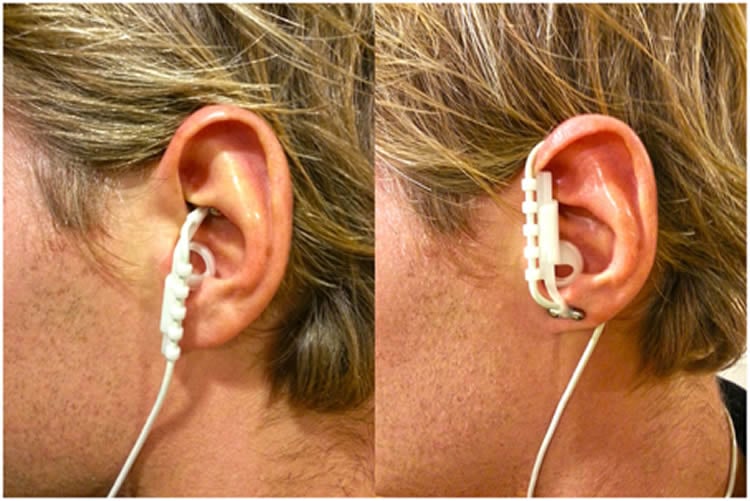Depression can be a devastating and unremitting problem.
Researchers of a new study published in the current issue of Biological Psychiatry report successful reduction of depressive symptoms in patients using a novel non-invasive method of vagus nerve stimulation, or VNS.
Despite the growing number of medications and neurostimulation approaches available, residual symptoms may be both distressing and disabling. Traditional vagus nerve stimulation (VNS) is a neurostimulation technique that has been used to alleviate treatment-resistant symptoms of depression. Clinical trials suggested that it produced modest benefit that emerged over long periods of time. However, it was also costly and required risky neurosurgery to implant the vagal nerve stimulators.
In this new study, Drs. Peijing Rong and Jiliang Fang at the China Academy of Chinese Medical Sciences, collaborating with Jian Kong’s research team at Harvard Medical School, investigated a new, modified form of VNS called transcutaneous VNS, which instead stimulates the vagus nerve through electrodes clipped onto the ear, similar to how headphones rest inside the ear.
Patients with major depressive disorder who volunteered for the study received either transcutaneous VNS or sham (placebo) VNS and underwent a functional neuroimaging scan both before and after one month of treatment.
Compared to patients who received sham VNS, the patients who received real VNS showed significant improvement of their depressive symptoms. This improvement was associated with increased functional connectivity between the default mode network and precuneus and orbital prefrontal cortex, an important network in the brain known to be altered in depression.
“The transcutaneous approach may make this treatment for depression more accessible to people with depression, providing it proves to retain the efficacy of the more direct form of vagal nerve stimulation,” said Dr. John Krystal, Editor of Biological Psychiatry.

Rong added, “This non-invasive, safe and low cost method of depression treatment can significantly reduce the severity of depression in patients and shows promise for future use.”
Funding: This work was funded by the Biotechnology and Biological Sciences Research Council (BBSRC) and is part of Newcastle University’s response to the challenges and opportunities presented by an ageing population. Newcastle University is a world leader in the field at its Campus for Ageing and Vitality which is supported by the National Institute for Health Research (NIHR) Biomedical Research Centre and the location for a new £40m National Centre for Ageing Science and Innovation (NASI).
Source: Elsevier
Image Source: The image is adapted from a Frontiers in Psychology paper by Jelle W. R. Van Leusden, Roberta Sellaro and Lorenza S. Colzato doi:10.3389/fpsyg.2015.00102
Original Research: Abstract for “Transcutaneous Vagus Nerve Stimulation Modulates Default Mode Network in Major Depressive Disorder” by Jiliang Fang, Peijing Rong, Yang Hong, Yangyang Fan, Jun Liu, Honghong Wang, Guolei Zhang, Xiaoyan Chen, Shan Shi, Liping Wang, Rupeng Liu, Jiwon Hwang, Zhengjie Li, Jing Tao, Yang Wang, Bing Zhu, and Jian Kong in Biological Psychiatry. Published online February 4 2016 doi:10.1016/j.biopsych.2015.03.025
Abstract
Transcutaneous Vagus Nerve Stimulation Modulates Default Mode Network in Major Depressive Disorder
Background
Depression is the most common form of mental disorder in community and health care settings and current treatments are far from satisfactory. Vagus nerve stimulation (VNS) is a Food and Drug Administration approved somatic treatment for treatment-resistant depression. However, the involvement of surgery has limited VNS only to patients who have failed to respond to multiple treatment options. Transcutaneous VNS (tVNS) is a relatively new, noninvasive VNS method based on the rationale that there is afferent/efferent vagus nerve distribution on the surface of the ear. The safe and low-cost characteristics of tVNS have the potential to significantly expand the clinical application of VNS.
Methods
In this study, we investigated how tVNS can modulate the default mode network (DMN) functional connectivity (FC) in mild or moderate major depressive disorder (MDD) patients. Forty-nine MDD patients were recruited and received tVNS or sham tVNS (stVNS) treatments.
Results
Thirty-four patients completed the study and were included in data analysis. After 1 month of tVNS treatment, the 24-item Hamilton Depression Rating Scale score reduced significantly in the tVNS group as compared with the stVNS group. The FC between the DMN and anterior insula and parahippocampus decreased; the FC between the DMN and precuneus and orbital prefrontal cortex increased compared with stVNS. All these FC increases are also associated with 24-item Hamilton Depression Rating Scale reduction.
Conclusions
tVNS can significantly modulate the DMN FC of MDD patients; our results provide insights to elucidate the brain mechanism of tVNS treatment for MDD patients.
“Transcutaneous Vagus Nerve Stimulation Modulates Default Mode Network in Major Depressive Disorder” by Jiliang Fang, Peijing Rong, Yang Hong, Yangyang Fan, Jun Liu, Honghong Wang, Guolei Zhang, Xiaoyan Chen, Shan Shi, Liping Wang, Rupeng Liu, Jiwon Hwang, Zhengjie Li, Jing Tao, Yang Wang, Bing Zhu, and Jian Kong in Biological Psychiatry. Published online February 4 2016 doi:10.1016/j.biopsych.2015.03.025







